AGL generates around 20% of the total capacity in Australia’s electricity market and supplies almost one-third of its households. The company is enormous.
So when its Chief Executive and Managing Director Brett Redman made the abrupt announcement that he would leave the company in April, just weeks after it had gone public with plans to split itself into two separate entities, one green and customer facing, the other brown and presumably less publicised, connections were inevitably drawn.
A report released today authored by Greenpeace’s Drew Rooke examines the company, specifically its pollution record (which is terrible), but in doing so shines light on AGL under Redman – which appears to have actively pitted itself against the global tide decarbonisation and opted to buy a series of coal generation plants extremely late in the game – as in, this decade late.
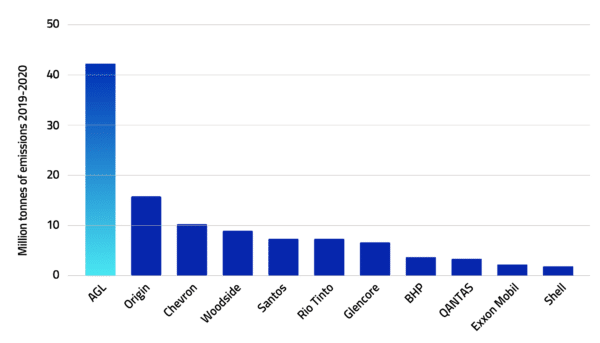
Greenpeace
Late pivot to coal
Unlike many of the other Australian institutions clinging to coal, AGL apparently isn’t doing so out of deep rooted loyalty. “In fact, only a decade ago it was widely considered the ‘greenest’ of Australia’s biggest energy retailers,” Greenpeace says Coal Faced: Exposing AGL as Australia’s biggest climate polluter.
In 2009, renewable energy actually accounted for about 34% of AGL’s total generation capacity. Today, in 2021, renewables account for just 10%.
Back to 2009, the year Obama was elected and two years into Kevin Rudd’s prime ministership, which was won on the back of a strong campaign for climate action. AGL was growing its renewables portfolio at an impressive yearly rate. Although the majority of its energy generation came from gas (48%), coal accounted for just 18% of its generation in 2009.
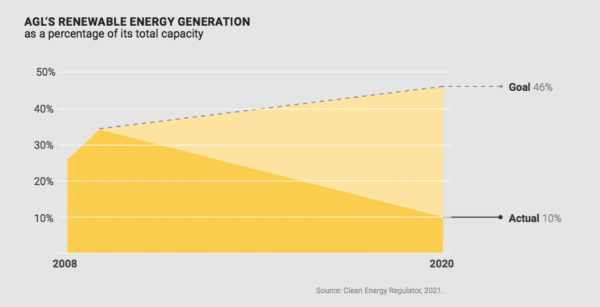
The company’s 2009 Annual Report also stated that in the future (an exact year was not given), it wanted to increase the share of renewable energy generation to 46% of its total capacity and decrease coal’s share to 11%.
That trajectory, however, was never realised. And Greenpeace lays the blame squarely at the feet of former CEO and Managing Director, Brett Redman.
Redman’s reign
Redman joined AGL in 2007 “after working for many years in large blue chip industrial companies.” By 2012, he was the company’s Chief Financial Officer.
It was in that role, Greenpeace says, he began to steer the company away from its clean energy plans and towards coal.
“Most significantly, he was primarily responsible for AGL’s acquisition of the Loy Yang A Power Station in 2012 and then of the Bayswater Power Station and the Liddell Power Station two years later.”
These three ageing plants represent over a quarter of Australia’s coal power station capacity and account for more than double the carbon emissions of Australia’s second biggest electricity generator (Origin). That’s more than BHP, Rio, Glencore and Qantas combined.
In 2020, the total electricity generation of these three coal-burning power stations was over 38,000 GWh – approximately 85% of AGL’s total electricity output for the year. Meanwhile. AGL’s renewables portfolio has held a stagnant 10% capacity for the last five years.
During this definitive but shockingly late turn towards coal at the expense of renewables, Redman was appointed was CEO and Managing Director of the company on a cushy $1,650,000 per annum. His held his role at the company’s helm from January 2019 to April 22, 2021.
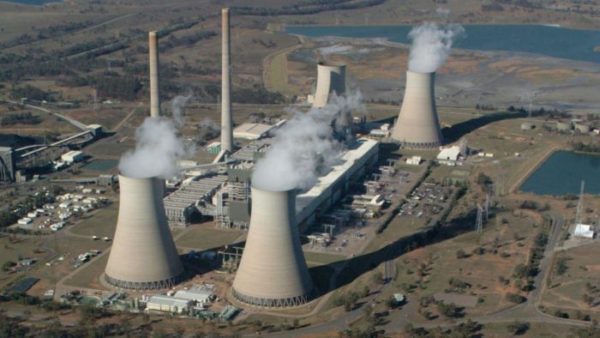
Image: abc.net.au
Shift in the tide
While it would be foolish to pin the turn in tide for stronger climate action to a single event, the ousting of Donald Trump and election of now U.S. president Joe Biden certainly helped shift the tone.
In the last six months, a wave of world’s biggest emitters, including the U.S. and China (but not Australia), have made commitments to be net-zero emissions by the middle of the century. Such monumental shifts have put pressure on the three major companies which dominate Australia’s biggest emitting sector: AGL, EnergyAustralia, and Origin Energy.
All three companies have spent the year loudly announcing renewable projects and plans. AGL, especially, has desperately been trying to shake its label as Australia’s largest climate change contributor.
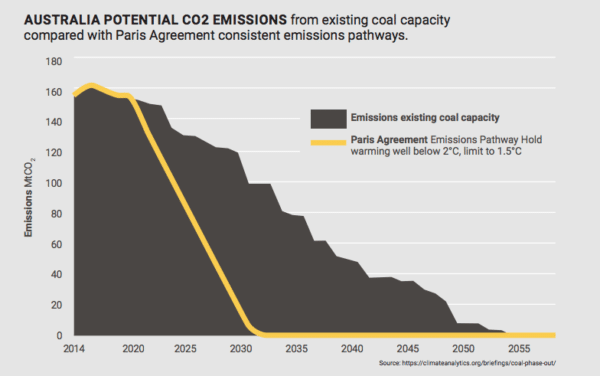
As part of its damage control, AGL announced in March that it would split in two. Its strange demerger would see it form “New AGL” which would manage electricity, gas and telecommunications retailing and “PrimeCo” which would operate the coal-burning power stations as well as some wind assets. Basically, the move would pave the way for New AGL to brand itself a green retailer without the assets of PrimeCo dirtying its record.
The market was incredulous. AGL remained in damage control, with Redman’s departure announcement four weeks later.
Greenpeace’s stated aim
Greenpeace said the aim of its report on AGL was to help its “120,000 shareholders, millions of customers, and the broader Australian public better understand the truth about the company, how it became Australia’s biggest emitter of greenhouse gases.”
It is trying to put pressure on the company to shift its trajectory at least back to the direction it was heading in 2009.
“As a giant in the Australian energy sector, AGL can ensure this transition happens as quickly as possible But at the moment it appears to be using its position and power to do the opposite,” the report says.
Redman’s replacement, Graeme Hunt, has doubled down on his predecessor’s plan to split the company into green and brown entities. In other words, there’s no evidence to suggest AGL will change its direction, even without Redman as its chief.
“It is not too late for AGL to take a different approach. Instead of clinging to coal until the bitter end, AGL can listen to the world’s scientific community about what is urgently required to avoid catastrophic climate change, follow the lead of some of its competitors in the Australian energy sector by closing all its coal-burning power stations before 2030, replacing them with renewable generation and prove through these actions that it is, as it claims, ‘helping to shape a sustainable energy future for Australia,’” Greenpeace’s author Rooke concluded.
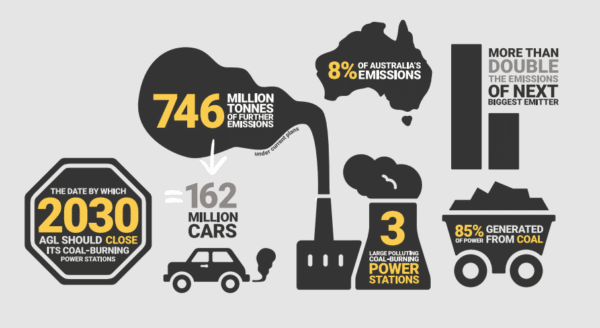
A spokesperson from AGL said the company has a target of net zero emissions by 2050 and commitments to exit coal-fired power that endure from AGL’s 2015 greenhouse gas policy.
This content is protected by copyright and may not be reused. If you want to cooperate with us and would like to reuse some of our content, please contact: editors@pv-magazine.com.
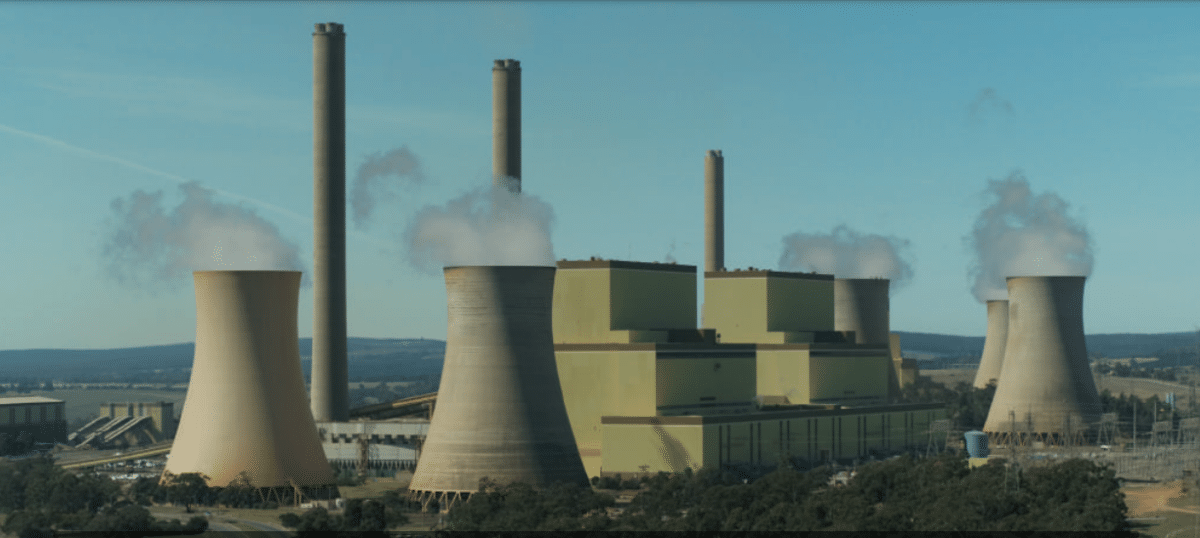








2 comments
By submitting this form you agree to pv magazine using your data for the purposes of publishing your comment.
Your personal data will only be disclosed or otherwise transmitted to third parties for the purposes of spam filtering or if this is necessary for technical maintenance of the website. Any other transfer to third parties will not take place unless this is justified on the basis of applicable data protection regulations or if pv magazine is legally obliged to do so.
You may revoke this consent at any time with effect for the future, in which case your personal data will be deleted immediately. Otherwise, your data will be deleted if pv magazine has processed your request or the purpose of data storage is fulfilled.
Further information on data privacy can be found in our Data Protection Policy.